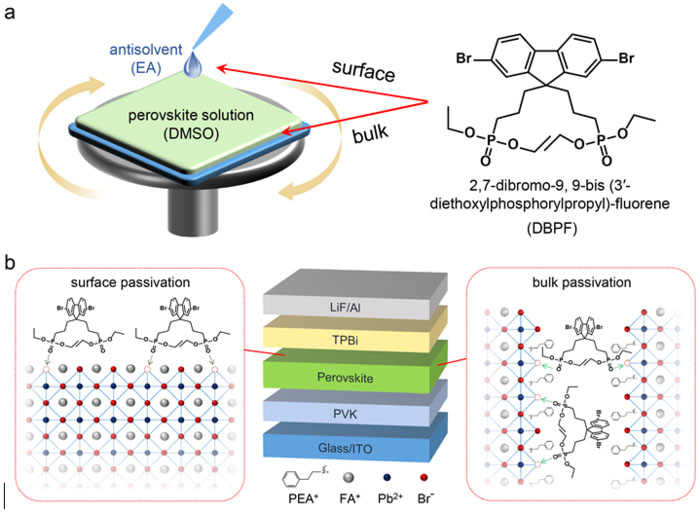| Mar 28, 2022 |
Inhibiting the thermal quenching of high-efficiency quasi-2D perovskite light-emitting diodes
(Nanowerk News) Metal halide perovskites are characterized by low-cost, high photoluminescence quantum yield, and high color purity. In recent years, perovskite light-emitting diodes are developing fast, with promising applications in lighting and display fields.
|
|
However, the ubiquitous thermal-induced fluorescence quenching in perovskite emitters lacks systematic research, and methods to suppress thermal quenching need to be further developed.
|
|
In a new paper published in Light Science & Application ("Suppressing thermal quenching via defect passivation for efficient quasi-2D perovskite light-emitting diodes"), a team of scientists, led by Professor Chuanjiang Qin from Changchun Institute of Applied Chemistry, Chinese Academy of Sciences have developed a passivation strategy for quasi-2D perovskite emitters to explore the relationship between defects and thermal quenching.
|
 |
| a Preparation of quasi-2D perovskite film and molecular chemical structure of DBPF passivation agent. b Schematics of device structure and passivation mechanisms. (Image: Dezhong Zhang, Yunxing Fu, Hongmei Zhan, Chenyang Zhao, Xiang Gao, Chuanjiang Qin, Lixiang Wang)
|
|
For the passivation agent of 2,7-dibromo-9,9-bis (3′-diethoxylphosphorylpropyl)-fluorene (DBPF), alkyl phosphates were selected as passivation functional groups for efficient defect passivation, while without affecting perovskite crystallization, and this is helpful to explore the direct relationship between thermal quenching and defects.
|
|
In addition, DBPF can be dissolved into both perovskite precursor solvent and antisolvent to achieve bulk passivation and surface passivation, which is benefit to further explore the relationship between defects in different landscapes and device performance including thermal stability.
|
|
According to the detailed impacts of passivation on thermal quenching characteristics, following mechanisms are proposed: “Defect-induced exciton-phonon coupling in the emitting region of quasi-2D films will aggravate the nonradiative recombination of exciton, leading to severe thermal quenching.
|
|
When the temperature is higher than 115 °C, higher-energy phonons will lead to the irreversible damage of emitting region in quasi-2D perovskite films, and this degradation can also be inhibited by defect passivation.”
|
|
The EQE peak values after surface passivation, bulk passivation and dual passivation can reach 21.5% , 19.3% and 22.2% respectively, higher than 18.1% of control device. The device with dual passivation can maintain 85% of the initial EQE at 85 °C, much higher than 17% of the control device.
|
|
“Our passivation strategy improves the performance of the device working at high temperature, and it is a direct evidence to prove that thermal quenching is closely related to defects. ”
|

